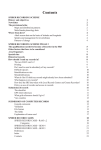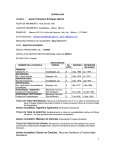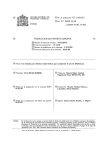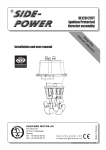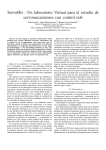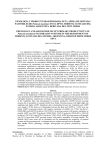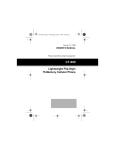Download Author`s personal copy
Transcript
Sitio Argentino de Producción Animal Author's personal copy Agroforest Syst DOI 10.1007/s10457-013-9663-4 Yield and growth features of Panicum maximum (Jacq.) var Trichoglume cv Petrie (Green Panic) under woody cover, Chaco region, Argentina C. Kunst • R. Ledesma • M. Castañares • M. Cornacchione • H. van Meer • J. Godoy Received: 16 May 2013 / Accepted: 7 December 2013 Ó Springer Science+Business Media Dordrecht 2013 Abstract Secondary forests and shrub thickets with low suitability for cattle raising are widespread in the Chaco region (NW Argentina). Concerns about the ecological sustainability of these ecosystems favor vegetation clearing methods for improving standing forage and accessibility for livestock operations that retain native tree and shrub species, a system called ‘silvopasture’ locally. These areas are characterized by a reduction of sunlight availability if compared with treeless pastures. The objective of this research was to assess the growth rate and the effect of two harvesting intervals (15 and 30 days) on the annual yield (BM) and forage quality of Panicum maximum (Jacq.) var Trichoglume cv Petrie (Green Panic) in such a system, using two approaches: successive harvests and functional, during three growth seasons (2000–01, 2001–02 and 2002–03). Correlation of growth features of Green panic with rainfall (mm), growing degree days (°C, GDD), and soil moisture (%) at two soil depths (0–15 and 15–30 cm) was also assessed. BM varied between 3,500 and 11,500 kg dry matter ha-1. The absolute growth rate presented two M. Castañares, Private consultant. C. Kunst (&) R. Ledesma M. Castañares M. Cornacchione H. van Meer J. Godoy Instituto Nacional de Tecnologı́a Agropecuaria, Estación Experimental Agropecuaria Santiago del Estero, Jujuy 850, G4200CQR Santiago del Estero, Argentina e-mail: [email protected] annual peaks, located in early and late summer, irrespective of growth season and harvesting interval. Growth season and harvesting interval significantly affected the relative growth rate (p [ F = 0.0015 and p [ F = 0.0002, respectively). BM was significantly correlated with rainfall and GDD observed between sampling dates, the magnitude of the coefficients were higher for the 30-day than for the 15-day harvesting interval. Correlation between BM and soil moisture content was not significant for both soil depths. Resting periods should be longer than 30 days to maintain the stability of the grazing system. Keywords Biomass Growth rate Roller chopping Silvopasture Harvesting interval Introduction The original vegetation of the Chaco region of Argentina was a mosaic of forests, woodlands, savannas and shrublands (Morello and Adamoli 1974). Timber operations exceeding regeneration rates, livestock overgrazing and misuse of fire have caused an increase of woody plant species in the current vegetation of the Chaco (Morello and Adamoli 1974). Concurrently, its suitability for livestock operations has decreased. The conversion of a woodland, shrub thicket or a dense secondary forest in a vegetation type more fitted for livestock operations is approached in the region by ‘roller chopping’. This 123 1 de 15 Sitio Argentino de Producción Animal Author's personal copy Agroforest Syst mechanical treatment crushes the woody undergrowth, creating a park-like structure and enhancing accessibility of both livestock and personnel. Trees with diameter at breast height (DBH) larger than 10–15 cm and tall shrubs are left standing, so a roller chopped paddock is characterized by a reduction of sunlight availability if compared with treeless pastures. Standing forage and stocking rate are increased by the sowing of grass instantaneously with the roller chopping treatment (Kunst et al. 2003). Species of the genus Panicum are commonly used, being P. maximum (Jacq.) cv trichoglume cv Petrie—locally referred as ‘Green panic’—one of the species of choice. Green panic possess the C4 photosynthetic process, it is a summer perennial and has a high nutritional quality and yield potential (Moreno et al. 1995). It is indigenous to tropical areas of southern Africa, where it occurs mainly in the subhabitat under the trees (Pieterse et al. 1997). Concerns about the sustainability of the Chaco ecosystem favor vegetation clearing methods that retain native tree and shrub species (Provincia de Santiago del Estero Law 6841 and further regulations 2007), and paddocks reclaimed with the procedure described above are commonly called a ‘silvopasture’. In this context, Green panic has a clear advantage over other grass species because its forage production is not adversely affected by shade (Tavares de Castro et al. 1999; Smit 2005; Ledesma 2006). Successful grazing management of the system described above requires quantitative information about the ‘forage quantity cycle’ (i.e. annual forage yield and growth rates) of the key grass species (Vallentine 2001). Yield, forage quality, the effects of harvesting frequencies and environmental features on varieties and species of Panicum have been studied in several ecosystems (Eriksen and Whitney 1981; Moreno et al. 1995; Durr and Rangel 2000; Penton 2000; Obispo et al. 2008; Ramirez Reynoso et al. 2009). However, there is a lack of such information for Green panic growing under a vegetation structure created by a roller chopping treatment in the Chaco region. Considering this paucity, the objective of this research was to determine: (a) total annual aboveground biomass yield, (b) growth rates, and (c) the effect of harvesting intervals on the relative growth rate and the aboveground biomass yield of the species in a roller chopped pasture. Relationships of these species features with environmental variables such as rainfall and soil moisture was also explored. The information gathered was used to develop management recommendations for Green Panic pastures growing under agroforestry systems in the Chaco region. Materials and methods Study area It was located in the ‘La Maria’ Experimental Ranch, Santiago del Estero Experimental Station, Instituto Nacional de Tecnologı́a Agropecuaria, Santiago del Estero, Argentina (28°30 S and 64°150 W). The climate is semiarid subtropical. Winter is cold and dry and summer is warm and rainy (Boletta 1988). The mean annual precipitation is 574 mm (Meteorological Station INTA Santiago del Estero Experimental Station, 1990–2008 series, occurring mainly from late October to early May (Boletta 1988, INTA Meteorological Station Santiago del Estero Experimental Station, unpublished report). Soils are Entic Haplustols, the most frequent suborder in the western Chaco region (Anrı́quez et al. 2005). Main characteristic of the soil profile is an organic matter content of 2–3 % and a high drainage rate due to the dominance of the silt fraction in its texture (Santiago del Estero Experimental Station, unpublished report). Permanent wilting point (PWP) of the soils of the experimental area is around 6.7 % (Lorenz, Personal communication). The experimental material was Green Panic seeded by hand after the roller chopper treatment in 1996 and 1997 of two 10 ha paddocks located in a highland ecological site. The original vegetation of the paddocks was a secondary forest with a homogeneous shrub stratum. After the roller-chopping treatment, the vegetation structure consisted of an uneven age tree and brush stand, with a mean distance between trees around 5–6 m, resulting in a density of 200–300 trees per hectare. Trees had an average height of 11 m and a DBH larger than 10 cm. Shrub mean height was around 3.5 m. The remaining mean total canopy ground cover of the trees was 75 %, while that of the shrubs was 35 %, visually estimated. The tree stratum was dominated by the native hardwood species Aspidosperma quebracho-blanco Schlecht (quebracho blanco) and Schinopsis lorentzii Griseb. Engl (quebracho colorado). The first is an evergreen species that 123 2 de 15 Sitio Argentino de Producción Animal Author's personal copy Agroforest Syst may reach a height of 20 m and a DBH of 80 cm; while the latter may reach a height of 25 m and a DBH of 1.50 m (Tortorelli 2009). Other tree species present were Zyzyphus mistol Griseb. and Prosopis nigra. (Griseb.) Hyeron. Shrub species present were Acacia furcatispina Burk., Celtis spinosa Spreng. and Capparis atamisquea Kuntze. Mean photon flux under the woody plant canopy during spring at noon at the ground, 0.5 and 1 m height aboveground was 21.71, 31 and 28 % of the available flux at the same height in full sunlight, respectively, as estimated by the LI-COR bar A-129 and measured at noon in summer (Kunst unpublished information). Field work Data on the temporal dynamics of the aboveground biomass (BM) of Green panic were gathered using the method of successive harvests as proposed by Anslow and Green (1967). Two groups of four permanent fixed plots of an area of 1 m2 each (total n = 8) were randomly laid in the center area of the first paddock, at mid distance from the watering point and the opposite corner, in order to avoid highly trampled soils. Locally, plots were located at an equal distance from the nearby tree/shrub, under their canopies (Fig. 1); and protected from grazing by cattle by a wire cage, fixed in the ground by iron stakes. An area of 0.25 m2 located in the center of each plot was harvested using hand scissors and stored in a paper bag. There was an average of 12 plants of Green Panic in each 0.25 m2 plot. The rest of the grass plants within a cage were harvested immediately after the samples were taken and the residues were left in the ground. The harvesting frequency of both plot groups was 28 days, but with a 14 day gap between them, from December 2000 and March 2001 (Castañares 2002). In a second step of the research, the effect of the harvesting interval on BM and on the relative growth rate of the species was assessed in the second paddock. Harvesting intervals of 15 and 30 days were applied at two groups of four plots each using the same procedure described above. These harvesting intervals were selected empirically, taking into account the rainstorm pattern of the Chaco: rains are usually frontal, resulting from the clash of tropical hot fronts with cold southern winds, occurring somewhat cyclically from late spring to early fall, approximately every 7–10 days (Ledesma N. personal communication). Therefore, a minimum sampling period of 15 days would increase the likelihood of at least one storm occurring between sampling dates. Sampling was performed during two growth seasons, from November 2001 to April 2002, and from November 0.25 m2 Plot 1 m2 Plot Fig. 1 Scheme showing the position of a plot in relation to tree and shrub canopies. Wire cage not shown 123 3 de 15 Sitio Argentino de Producción Animal Author's personal copy Agroforest Syst 2002 to April 2003; respectively. Plot location was changed every year using the same sampling procedure as described. In both stages of the study, the initial sampling date (day = 0) was selected based on weather forecasts for the study area and at least 3 days before a rain. In that sampling date, all plants in a plot were cut and the residues discarded. Throughout the study, the stubble height (remaining plant tissue) was set at 10 cm from the ground, a height commonly used by Chaco cattlemen (Ledesma 2006, Kunst personal observation). Plant samples were transported to the lab and oven dried at 60 °C for 48 h. In all harvested material leaf and shoot fractions were separated by hand and weighed. Results were expressed as kg of dry matter per hectare (kg DM ha-1). Weather and soil moisture monitoring Rainfall at the study sites was collected in a micro raingauges located near the sampling plots. Data were collected every 2 weeks during the wet season. Rainfall (mm) and air temperature (°C) collected at the INTA Meteorological Station located in the Ranch headquarters (7 km from the experimental area), were used as a ‘master’ record since observations are taken every day. Data of air temperature were used to calculate the growing degree days observed between sampling dates (GDD), as follows (Gómez de la Fuente et al. 2007; Smart et al. 2007): GDD ¼ RððTmax Tmin Þ=2Þ Tbase Þ ð1Þ where Tmax is the maximum air temperature (°C), Tmin is the minimum air temperature (°C) and Tbase is 15 °C. Growth of Green Panic is restricted at air temperatures lower than 15 °C (Ivory and Whiteman 1978) while optimum air temperature for photosynthesis is 34 °C (Chacon-Moreno et al. 1995). Soil water content (SM) was assessed by the gravimetric method in each harvesting date. Three random samples were taken near the cages at two soil depths: 0–15 cm (SM15) and 15–30 cm (SM30). Forage quality analysis Samples of BM comprising total, leaf and shoot fractions gathered for the estimation of the growth curve (2000–01) were hand separated and analyzed for crude protein and acid detergent fiber, after sample grinding in a Wiley mill milling and screening through a 1 mm mesh. Crude protein content was estimated by the Kjeldahl method. Acid detergent fiber was estimated by the Van Soest method (Castañares 2002). For the 2000–01 and 2001–02 growth seasons, the leaf/shoot ratio of each sample was calculated and averaged for each harvesting periods and sampling dates, and plotted versus time to assess its behavior. Mathematical and statistical analysis Growth features of Green panic were estimated using two approaches: (a) the harvesting method (Anslow and Green 1967), and (b) the functional approach (Hunt 1982). In the first method, the mean standing BM of Green Panic was calculated for each sampling date, plot group and growth season. In a second step, a curve of mean accumulated BM was determined by summing up the successive BM observed until a specific date. The magnitude of the rate of BM between two harvesting dates—an estimation of the mean absolute growth rate (AGR) of the species—was estimated by calculating the difference of the mean accumulated BM between sampling dates tn and tn?1 divided by the interval of time between these dates expressed in days (Hunt 1982, formula [2]): AGRhi kg DM ha1 day1 ð2Þ ¼ ðBMtþ1 BMt Þ=ðtnþ1 tn Þ where BMt?1 is the aboveground biomass harvested at the sampling date t ? 1; BMt the aboveground biomass harvested in the sampling date t, and h harvesting period, 1 and 2 and i = plots 1 to n. Accumulated BM and AGR were plotted versus time to assess its annual pattern. The functional approach was applied by fitting growth models to the accumulated BM curves classified by growth season and harvesting interval by nonlinear regression (Hunt 1982). For the 2000–01 season the Richards function (Hunt 1982) presented the lowest mean square error, and was selected as the best equation to model the accumulated BM curve throughout time (formula 3): h id ABM ¼ a 1 þ expðbC daysÞ ; ð3Þ where ABM is the accumulated aboveground grass biomass (kg DM ha-1); a is the coefficient representing the maximum grass productivity (kg DM ha-1); b 123 4 de 15 Sitio Argentino de Producción Animal Author's personal copy Agroforest Syst is the starting value (kg DM ha-1); C = the ‘intrinsic rate of increase’, representing an average growth rate per cápita of the dry matter (kg DM ha-1 day-1). C could be interpreted as an average AGR that ignore short term fluctuations of the environmental parameters. The coefficient ‘d’ controls whether or not the function has an inflection, and if so, where it occurs (Tsoularis and Wallace 2002). For the 2001–2002 and 2002–2003 seasons and for each harvesting frequency, a three parameter logistic growth function presented the lowest mean square error and was selected to model the dynamics of ABM throughout time (formula 4, Overman and Scholtz III 2002): ABM ¼ a . 1 þ b:expðC daysÞ ; ð4Þ with all parameters as above. The parameters of Eqs. [3, 4] were estimated using the package INFOSTAT (INFOSTAT 2008), that uses the simplex and/or the Levenberg–Marquardt methods to estimate equation coefficients. The pattern of the absolute growth rate and the location of the inflection point of the accumulated BM curves were used to identify the pattern of increase and decrease of growth rate throughout time and used as an indication to define periods of grazing and rest of P. maximum. The inflection point of a curve is the point when its curvature changes sign, and the growth rate is maximum (Tsoularis and Wallace 2002). Time to inflection, and the maximum growth rate observed at the time of inflection for the Richards and logistic equations were calculated using formulas provided by Tsoularis and Wallace (2002). Differences in the relative growth rate between the two harvests were tested using a two-way random ANOVA with ln-transformed BM collected in each sampling date as dependent variable; and growth season (classification factor, n = 2, 2001–02 and 2002–03), harvesting interval (treatment, n = 2, 15 and 30 days, respectively); and their interaction as independent variables, using a repeated measures approach (Araujo 2003; Ramirez Reynoso et al. 2009). The model had no intercept. Each plot was considered a replication for a treatment (n = 4 by harvesting date). Conceptually, harvesting intervals represent grazing intensities, while growth seasons represent different weather environments. The PROC MIXED procedure of the SAS package (SAS 1998; Littell et al. 1998) was used for calculations. Differences in the mean relative growth rate among growth seasons and harvesting frequencies were tested using the LSMEANS statement (SAS 1998). An a = 0.05 was used for all statistical analysis. We used the Kendall’s s, a non parametric correlation coefficient (Conover 1980) to assess the relationships between the time series of the mean accumulated BM with the time series of SM15, SM30, and the rainfall amount and GDD observed between sampling dates for each growth season and harvesting period. The Kendall coefficient was used because the relationship among these variables was expected to be monotonic but not linear (Conover 1980). To assess any delay in plant response the time series were lagged one sampling date (Khan 1971; Gibbens 1991). Statistical significance was assumed at p B 0.05. The PROC CORR procedure of the SAS package was used for calculations (SAS 1998). Results Growth features In the three growth seasons assessed, the plants of Green Panic started to grow with 30–40 mm of monthly accumulated rainfall and a GDD above 150 °C. Growth slowed and eventually stopped when the GDD between harvesting dates was less than 100 °C and air temperatures fell under 15 °C, irrespective of the amount of rainfall fallen. The growth period of the species lasted from 6 to 7 months; from mid/late spring to early fall (from October–November to March–April, Figs. 1, 2, 3). Green Panic did not grow during the rest of the year (fall to late winter, May to early October). Irrespective of growth season, the growth curve of Green Panic presented three phases, separated by two peaks of AGR: the initial phase, which began in October-early December and lasted to late December-mid January; a middle phase, from mid-January to mid-February; and a final phase, lasting from late February to late March-early April (Figs. 2, 3, 4, 5, 6). These two peaks of AGR were consistently identified despite harvesting intervals: the first was observed at the end of December–early January (early summer, an average of 50 days after the beginning of the sampling) and the second from early February-late March (late summer—early fall, an average of 131 days after the beginning). The first AGR 123 5 de 15 Sitio Argentino de Producción Animal Author's personal copy Agroforest Syst Fig. 2 Aboveground biomass accumulation curve (BM) and absolute growth rate (AGR) of P. maximum cv. Trichoglume cv Petrie (Green Panic) for the 2000–01 season. ‘La Maria’ Experimental Ranch, INTA Santiago del Estero, Argentina. References: rainfall, AGR and growing degree days (GDD) correspond to the time period between harvesting dates. ‘BM plot group 1’ and ‘BM plot group 2’ are BM as estimated by the successive harvests approach, and ‘BM curve’ is the BM as estimated by the functional approach Fig. 3 Aboveground biomass accumulation (BM) and absolute growth rate (AGR) for the 15-day harvesting interval of P. maximum cv. Trichoglume cv Petrie (Green Panic), as estimated by the successive harvests approach, 2001–02 growth season. ‘La Maria’ Experimental Ranch, INTA Santiago del Estero, Argentina. References: rainfall, AGR and growing degree days (GDD) correspond to the period comprised between sampling dates 123 6 de 15 Sitio Argentino de Producción Animal Author's personal copy Agroforest Syst Fig. 4 Aboveground biomass accumulation (BM) and absolute growth rate (AGR) for the 30-day harvesting interval of P. maximum cv. Trichoglume cv Petrie (Green Panic), as estimated by the successive harvests approach, 2001–02 growth season. ‘La Maria’ Experimental Ranch, INTA Santiago del Estero, Argentina. References: rainfall, AGR and growing degree days (GDD) correspond to the period comprised between sampling dates Fig. 5 Aboveground biomass accumulation (BM) and absolute growth rate (AGR) for the 15-day harvesting interval of P. maximum cv. Trichoglume cv Petrie (Green Panic), as estimated by the successive harvests approach, 2002–03 growth season. ‘La Maria’ Experimental Ranch, INTA Santiago del Estero, Argentina. References: rainfall, AGR and growing degree days (GDD) correspond to the period comprised between sampling dates 123 7 de 15 Sitio Argentino de Producción Animal Author's personal copy Agroforest Syst Fig. 6 Aboveground biomass accumulation (BM) and absolute growth rate (AGR) for the 30-day harvesting interval of P. maximum cv. Trichoglume cv Petrie (Green Panic), as estimated by the successive harvests approach, 2002–03 growth season. ‘La Maria’ Experimental Ranch, INTA Santiago del Estero, Argentina. References: rainfall, AGR and growing degree days (GDD) correspond to the period comprised between sampling dates peak presented a larger magnitude than the second AGR peak in the three growth seasons studied (Figs. 2, 3, 4, 5, 6). The mean total accumulated BM of Green Panic in these 6–7 months calculated by the harvesting method varied between 3,500 and 11,500 kg DM ha-1 (Figs 1, 2, 3, 4, 5). The logistic and Richards functions fitted well the accumulated BM data throughout time: R2 = 0.98 in all cases (Table 2). The asymptote of the Richards function (coefficient ‘a’) varied between 3,500 and 12,237 DM. ha-1 (Table 2). The R2 between the field and the estimated data was 0.98, although both functions used overestimated BM toward the end of the growth season. The coefficient C was almost constant in all growth models (Table 2).The functional approach identified only one AGR peak as suggested by the inflection point of the curve, and its location varied according to the growth season, from 22 to 97 days since day = 0 (Table 2). In the inflection point, the magnitude of the calculated maximum growth rate was of similar magnitude of the first AGR peak in all growth seasons as calculated by the harvesting method (Table 2). Growth season and harvesting interval significantly affected the relative growth rate (p [ F = 0.0015 and p [ F = 0.0002, respectively) while the interaction between harvesting frequency and growth season was not significant. The mean relative growth rate of the 2001–02 season was higher than the mean relative growth rate of the 2002–03 season. The 30-day harvesting period presented a mean relative growth rate twice as high as the mean relative growth rate of the 15-day harvesting period, 1,820 versus 500 kg MS ha-1, respectively (p \ 0.05, Figs. 5, 6). The final accumulated BM of the 15-days harvesting interval was 39–42 % less than the 30-day harvesting interval (Figs. 2, 3, 4, 5, 6). 123 8 de 15 Sitio Argentino de Producción Animal Author's personal copy Agroforest Syst Forage quality During the 2000–01 season, the leaf/shoot ratio was *1.6–2.1 from the beginning of the growth until the end of February, and then the ratio increased up to seven toward the end of the season (Fig. 8). The other two seasons presented similar results. The mean protein content of the leaf and shoot fractions were 14.76 and 7.95 %, respectively. Mean acid detergent fiber was 69.93 and 76 % for both fractions, respectively. In the 2001–02 season, the leaf:shoot ratio increased again toward the end of the season in both harvesting intervals, but the 15-day harvesting interval showed the largest increase. Environmental dynamics In the 2000–01, 2001–02 and 2002–03 growth seasons the total rainfall amount in the study area was 577, 739.8 and 891.7 mm, respectively. The GDD were 1,492, 1,643 and 1,956 °C for the same seasons, respectively. The last growth season was unusual: the rainfall showed two peaks: one at the beginning and another at the end of the growth season, separated by a period of low rains and a peak of GDD during January (Figs. 5, 6). During the first season the soil moisture showed an increasing trend, and was above the soil wilting point at the end of the study period (Fig. 7a). On the other hand, soil moisture presented a decreasing trend in the second and third seasons (Fig. 7b, c), being the mean soil moisture content consistently under the potential wilting point during the third season (Fig. 7c). In all cases, the soil moisture was higher at the top soil horizon than at the deeper soil horizon at the beginning of the growth period and then slowly decreased. Correlations between growth features and environmental variables At the seasonal scale, the higher accumulated BM were observed in the 2002–01 season and the lowest in 2002–03 season, irrespective of harvesting interval (Table 2). Although the third growth season presented the highest total rainfall of the three seasons, the annual accumulated BM was the smallest of the three, showing a decrease in both harvesting intervals (Figs. 4, 5). At the intra-seasonal scale, the annual time series of BM was significantly correlated with the time series of the rainfall and the GDD between sampling dates (Table 3a). The time series of BM sorted by harvesting frequencies presented the same significant correlations, but the magnitude of the coefficients were higher for the 30 day harvesting interval than for the 15-day harvesting interval (Table 3b). Correlations between the mean BM and the mean SM were not significant for both soil depths. Discussion The average maximum ‘yield’ of Green Panic in this study ranged from 3,500 to 11,500 kg DM ha-1, for the lower and higher harvesting interval, respectively (Table 1). The reduction of the photon flux observed in this study is similar to those reported in other studies involving roller chopper treatments, suggesting a conservative vegetation clearing approach (Ledesma 2006, Kunst et al. 2012). These yields present no practical difference with those reported for Green Panic growing in full sunlight in the Chaco region of Argentina, ranging from 4,600 to 8,000 kg DM ha-1, irrespective of harvesting interval (Ricci et al. 1997; De León et al. 1995a; De León 1999). The two peaks of growth observed have been also reported by De León (1999) for Green Panic growing under full light conditions in the Chaco region. Ramirez Reynoso et al. (2009) working with P. maximum ‘Mombaza’ in full light conditions with 1,000 mm of annual summer rainfall reported AGR of 66–140 kg DM ha-1 day-1, for cutting intervals of 3 and 7 weeks, respectively. These magnitudes are within the range observed in this study. The depression in BM observed between growth peaks in early-mid summer (January–February) is attributed to the fact that in the Chaco region, January presents usually the highest annual air temperatures, as the GDD pattern indicates (Figs. 2, 3, 4, 5, 6) suggesting an extreme water demand that Green panic was not able to withstand. The final decline of the absolute growth rate at the end of the growth season could be attributed to lower air temperatures. The lowest Green Panic annual yield was registered in the 02–03 season, which also presented the largest rainfall amount. This result could be attributed to the rather unusual rainfall pattern and the high evaporative demand of that season, as suggested by the annual GDD. The parameters of forage quality gathered in this study are quite similar to those reported for Green 123 9 de 15 Harvesting intervals (days) 1 Jan 3 Dec 17 Dec 28 Dec 12 Jan 1 157.73 99.23 117.75 37.06 55.6 Dec 6 Oct 26 Oct 10 Date observed 1st AGR peak Yield (kg DM ha-1 day-1) Day 01 Day since harvesting interval was counted 30 2002–03 15 30 2001–02 15 2000–01 28 Growth season 61 65 57 46 28 Number of days since day 0 519.5 231 254 212 167 Accumulated rainfall until first AGR peak (mm) 30.8 18.63 120.80 73.5 94.83 April 10 Mar 13 Mar 3 Feb 27 Feb 14 Yield Date (kg DM ha-1 day-1) observed 2d AGR peak 184 134 133 118 70 Number of days since day 0 879 771 690 668 589 Accumulated rainfall until second AGR peak (mm) 5,800 3,500 11,500 6,700 7,300 Total Accumulated BM during study period (kg DM ha-1) Table 1 Accumulated aboveground biomass, absolute growth rates (AGR) of Panicum maximum cv trichoglume cv Petrie (green Panic) under woody cover as estimated by the successive harvests approach for three growth seasons, 2000–01, 2001–02 and 2002–03. ‘La Maria’ Experimental Ranch, Santiago del Estero Experimental Station, Santiago del Estero, Argentina Author's personal copy Sitio Argentino de Producción Animal Agroforest Syst Fig. 7 Dynamics of soil water content (SM, %) for a 2000–01, b 2002–03 and c 2002–03 growth seasons at two soil depths: 0–15 and 15–30 cm. ‘La Maria’ Experimental Ranch, Santiago del Estero Experimental Station. Argentina. References: PWP permanent wilting point Panic growing under full sunlight in the Chaco by De León et al. (1995b) and by Obispo et al. (2008) for a silvopastoral system under medium shade. In this study the grazing history was represented by the harvesting interval and by the ‘stubble height’, or plant tissue left for the plant to recover after the 123 10 de 15 Sitio Argentino de Producción Animal Author's personal copy Agroforest Syst 22.5 17-Apr-02 3-Apr-02 14-Mar-02 27-Feb-02 11-Feb-02 21-Jan-02 28-Dec-01 17-Dec-01 15-Nov-01 0 Sa m pli ng da te s Leaf:shoot ratio 45 5-Nov-01 15 days 30 days Harvesting interval Fig. 8 Leaf:shoot relationship of P. maximum cv. Trichoglume cv Petrie (Green Panic) under woody plant canopy in a roller chopper treatment, for two harvesting regimes, 2001–02 season. La Maria Experimental Ranch, Santiago del Estero Experimental Station. Argentina harvest. In full sunlight environments it has been reported a negative association between the magnitude of the absolute growth rate and a high cutting frequency; while a positive, increasing trend in the yield of Panicum species as the harvesting interval increases (Moreno et al. 1995; Gonzalez et al. 1997, De León et al. 1995b; Ricci et al. 1997, De León 1999; Ramirez Reynoso et al. 2009). The compensatory responses to tissue removal (i.e. the magnitude of AGR after each cut) in our study seems were not enough to maintain a high rate of BM accumulation when the harvesting interval was 15 days. Low stubble heights, as used in this study, could be also the cause of the small magnitude of the second AGR peak. Higher stubble heights (larger than 20 cm) are associated to higher aboveground biomass yields in Panicum species (do Canto Weber et al. 2008; Ramirez Reynoso et al. 2009, Kiss Trocsanyi et al. 2009). The production of tillers is one of the main phases of vegetative grass growth: if this process is affected the final productivity will suffer a reduction since tillering is required to maintain exponential growth and to produce biomass, i.e. forage (Groeneveld 1998; Carrillo 2003; Santos et al. 2003). Since the leaf area is reduced, frequent cuttings cause a decrease in tiller production, thus the ability of a plant to replenish reserves or produce additional new tillers is restricted. Plants cut near the ground rely on basal buds to recover instead of aerial buds located in tillers, a process that takes some time (Chacon-Moreno et al. 1995). The increase in the leaf:shoot ratio toward the end of the growth season in Green Panic showed in this study also suggest a deleterious effect in tillering, caused most likely by the frequent cutting. The soil moisture failed as a predictor of BM, as indicated by the lack of significance of the correlation between its time series. This result has been reported in other studies of grass yield-soil moisture relationships (Smart et al. 2007) and could be attributed to the inherent high drainage of the soils of the study area, and also to the lack of adjusted timing between the sampling schedule and the rainfall occurrence. Management implications Although the growth pattern of Green Panic followed the weather pattern as the native species do, the maximum expected aboveground production for Green Panic under woody cover (*shadow) estimated for a silvopasture created by roller chopping and with 20–30 % of photon flux was quite similar to Green Panic growing under full sunlight, and greater than the reported productivity of native ‘open’ grasslands, estimated as 5,000 kg DM ha-1 of standing crop (Kunst et al. 2006). Parameters of forage quality were also very similar. This information suggests that Green Panic is a good choice to reclaim paddocks in poor range condition and dominated by woody plants, without drastically altering the ecosystem, sustaining the approach of creating an agroforestry system in the Chaco. Environmental impact is reduced when trees and shrubs are maintained in a paddock (Jackson and Ash 1998; Obispo et al. 2008). In fact, soil structure, fertility, porosity and water storage capacity are improved under trees and shrubs, a fact reported for the Chaco region in experiments involving rollerchopping treatments (Anrı́quez et al. 2005; Ledesma 123 11 de 15 Sitio Argentino de Producción Animal Author's personal copy Agroforest Syst Table 2 Growth features of Panicum maximum cv trichoglume cv Petrie (green Panic) under woody cover as estimated by the functional approach for three growth seasons, 2000–01, Season Harvesting intervals (days) Parameters 2000–01 28 a 9205.14 b -0.73 C 2001–02 15 30 2002–03 15 30 Estimate 2001–02 and 2002–03. ‘La Maria’ Experimental Ranch, Santiago del Estero Experimental Station, Santiago del Estero, Argentina Error p value R2 Time to inflection point since day = 0 (days) Max C kg DM ha-1 day-1 0.98 22 160.96 0.983 69 67.47 0.989 83 116.96 0.98 80 34.29 0.982 97 56.69 0.040 d 3.25 a 6922.42 b 15.68 4.66 0.0083 C 0.04 0.01 0.01 a 12237.06 840.8 0.0001 b 27.86 13.27 0.1037 \0.0001 345.22 C 0.04 a 3503.91 0.01 0.0046 b 11.14 C 0.03 a 5735.21 587.2 0.0103 b 48.22 60.88 0.51 C 0.04 0.01 0.0924 \0.0001 176.88 3.29 0.0117 4.5E-03 0.0002 a maximum aboveground biomass accumulation, BM (kg DM ha-1), b starting coefficient, c intrinsic rate of increase of aboveground biomass accumulation (kg DM ha-1 day-1) For other references, see text 2006; Albanesi 2012; Albanesi et al. 2012; Anriquez et al. 2012) and other ecosystems (Belsky et al. 1993; Obispo et al. 2008). Also, shade increases livestock comfort and forage has a better nutritional quality (Bordon 1988; Belsky et al. 1993; Ledesma 2006; Treydte et al. 2007; Ludwig et al. 2008; Obispo et al. 2008). The recurring periods of grazing and resting of a pasture require quantitative assessment on forage growth rates and how these growth rates vary throughout time and the influence on environmental factors, so both productivity and persistence are maintained (Gillen and McNew 1987). In semiaridarid areas the forage quality is of lesser importance than yield, since the rainfall regime is seasonal and the opportunity to replace grazed organs is directly related to water availability and proper resting so the removal of tissue is equilibrated by the growth processes. The harvesting intervals in this study were selected empirically, based on the pattern of storms that bring moisture to the Chaco environment. They give an insight of the grazing interval needed to assure the persistence of Green Panic pastures in roller-chopper paddock, information related to both economic and ecological sustainability of livestock operations. In semiarid-arid areas the period of resting/deferment plays a key role in the sustainability of a pasture throughout time (Reese 1993; O’Reagain and Ash 2002). The information gathered in this research suggest that for a roller-chopped paddock with Green Panic in the Chaco a grazing system with a resting interval higher than 30 days and stubble heights higher than 10 cm could be recommended to get high yield, high water efficiency and appropriate persistence of the plants throughout time. Results also indicate that a paddock may be grazed 2–3 times during the rainfall season, a fact that should be taken into account when planning average stocking rates and persistence in time of a pasture. 123 12 de 15 Sitio Argentino de Producción Animal Author's personal copy Agroforest Syst Table 3 Kendall’s s correlation coefficient and its significance between environmental variables and accumulated aboveground biomass harvested in each sampling date of Panicum maximum cv trichoglume cv Petrie (Green Panic): a by growth season and b by growth season sorted by harvesting intervals, 2001–02 and 2002–03 (A) Growth season Environmental variables 01–02 Rainfall between sampling dates BM s Growing degree days 0203 0.55 p [ |s| 0.002 s 0.38 p [ |s| 0.03 Rainfall between sampling dates s 0.62 p [ |s| 0.0034 Growing degree days s 0.72 p [ |s| 0.0006 (B) Growth season Environmental variables 01–02 Rainfall between sampling dates Growing degree days 02–03 References HI15: 15 day harvesting interval; HI30: 30 day harvesting interval Rainfall between sampling dates Growing degree days Acknowledgments Research was supported by the Instituto Nacional de Tecnologı́a Agropecuaria (INTA) through Specific Research Project ‘Desarrollo de sistemas silvopastoriles’ and INTA Tucuman – Santiago del Estero Regional Center, Research and Extension Project ‘Intensificación de la Producción de Carne Bovina del Noroeste Argentino, 1999–2004’. We would like to thank Dr Hugh Dove, CSIRO Australia, for its suggestions that greatly improved this manuscript. References Albanesi A. (2012) Suelos en sistemas silvopastoriles de la región chaqueña. In: Arroquy J, Ledesma R, Roldan Bernhard S, Gómez A (eds.) Proc 2nd Congreso Nacional de Sistemas Silvopastoriles, INTA Santiago del Estero, p 212–220 Albanesi A, Anriquez A, Silberman J, Kunst C, Duffau A, Dominguez Nuñez J (2012). Fracciones de carbono orgánico del suelo en rolados en el Chaco semiárido. In: Arroquy J, Ledesma R, Roldan Bernhard S, Gómez A (eds.) Proc o2d Congreso Nacional de Sistemas Silvopastoriles, INTA Santiago del Estero, p 212–220 Anriquez A, Albanesi A, Silberman J, Kunst C, Suarez R, Domı́nguez Nuñez J (2012). Densidad aparente y materia orgánica del suelo en rolados del Chaco Semiárido. In Arroquy J, Ledesma R, Roldan Bernhard S, Gómez A (eds.) Proc. 2d Congreso Nacional de Sistemas Silvopastoriles, INTA Santiago del Estero, p 299–304 HI15 HI30 s 0.42 0.73 p [ |s| 0.07 0.04 s 0.38 0.47 p [ |s| 0.10 0.18 s 0.44 0.66 p [ |s| 0.095 0.17 s 0.55 1.00 p [ |s| 0.04 0.04 Anrı́quez A, Albanesi A, Kunst C, Ledesma R López C, Rodriguez Torresi, Godoy J (2005) Rolado de fachinales y calidad de suelos en el Chaco occidental, Argentina. Ciencia del Suelo (Argentina) 23: 145–157 Anslow R, Green J (1967) The seasonal growth of pasture grasses. J Agric Sci Camb 68:109–122 Araujo A (2003) Analysis of variance of primary data on plant growth analysis. Pesqui agrop Brasileira (Brasilia) 38:1–10 Belsky A, Mwonga S, Duxbury J (1993) Effects of widely spaced trees and livestock grazing on understory environments in tropical savannas. Agrofor Syst 24:1–20 Boletta P (1988) Clima. Ch. 1, p. 7–15. In: Desmonte y habilitación de tierras en la región Chaqueña semiárida. Oficina Regional de la FAO para America Latina y el Caribe, Santiago Canto Weber do M, Cabreira Jobim C, Gasparino E, Hoeschl A (2008) Caracteristicas do pasto e acumulo de forragem em capim-tanzania submetido a alturas de manejo do pasto. Pesqui Agrop Brasileira, Brasilia 43:429–435 Carrillo J (2003) Manejo de pasturas. Ediciones INTA, Buenos Aires Castañares M (2002) Curvas de crecimiento y calidad forrajera de Panicum maximum var. Trichoglume cv. Green Panic bajo cobertura arbórea en un ambiente rolado. Graduate Thesis, Facultad de Agronomı́a y Agroindustrias, Universidad Nacional de Santiago del Estero, Santiago del Estero Chacon-Moreno E, Rada F, Sarmiento G (1995) Intercambio gaseoso, nitrógeno foliar y optimación en el manejo de Panicum maximum (tipo común) sometido a diferentes frecuencias de corte. Turrialba 45:19–26 123 13 de 15 Sitio Argentino de Producción Animal Author's personal copy Agroforest Syst Conover W (1980) Practical nonparametric statistics, 2nd edn. Wiley, New York De León M (1999). Las pasturas subtropicales en la región semiárida central del paı́s. p 15–34. Simposio Internacional de Forrajeras Subtropicales, Facultad de Agronomı́a y Zootecnia, Universidad Nacional de Tucumán, Tucumán De León M, Peuser R, Boetto G, Luna G, Bulaschevich M (1995a) Efecto del genotipo y la frecuencia de defoliación sobre la producción de materia seca en gramı́neas megatérmicas cultivadas. Rev Arg de Prod Anim 15:226–228 De León M, Peuser R, Boetto G, Luna G, Bulaschevich M (1995b) Efecto de la frecuencia de defoliación y del genotipo y sobre la calidad del rebrote forraje producido en gramı́neas megatérmicas. Rev Arg de Prod Anim 15:229–231 Durr F, Rangel J (2000) The response of Panicum maximum to a simulated subcanopy environment. I Soil 9 shade interaction. Trop Grass 34:110–177 Eriksen F, Whitney S (1981) Effects of light intensity on growth of some tropical forage species. I. Interaction of light intensity and nitrogen fertilization on six forage grasses. Agrofor J 73:427–433 Gibbens R (1991) Some effects of precipitation patterns on mesa dropseed phenology. J Range Manag 44:86–90 Gillen J, McNew R (1987) Seasonal growth rates of tallgrass prairie after clipping. J Range Manag 40:342–345 Gómez de la Fuente E, Dı́az Solı́s H, Saldı́var Fitzmaurice A, Briones Encinia F, Vargas Tristán V, Grant W (2007) Patrón de crecimiento de pasto buffel [Pennisetum ciliare (Link.) Sin. Cenchrus ciliaris] en Tamaulipas México. Tec Pec en México 45:1–17 Gonzalez R, Delgado H, Faria Mármol D, Morillo D (1997) Evaluación de cultivos puros y asociados de Panicum maximum y Centrosema sp. Interrelacionados con frecuencias de corte. Archivos Latinoamericanos de Producción Animal, Suplemento 1:63–65 Groeneveld H (1998) Measuring the RGR of individual grass plants. Ann Bot 82:803–808 Hunt R (1982) Plant growth curves. The functional approach to plant growth analysis. University Park Press, Baltimore, p 249 Infostat (2008) InfoStat, versión 2008. Manual del Usuario, 1st edn. Grupo InfoStat Universidad Nacional de Córdoba, Facultad de Ciencias Agrarias, Córdoba Ivory D, Whiteman P (1978) Effect of temperature on growth of five subtropical grasses. I. Effect of day and night temperature on growth and morphological development. Aus J Plant Phys 5:131–148 Jackson J, Ash J (1998) Tree-grass relationships in open eucalypt woodlands of northeastern Australia: influence of trees on pasture productivity, forage quality and species distribution. Agro Syst 40:159–176 Khan ACh (1971) Rainfall pattern and monthly forage yields in the Thai ranges of Pakistan. J Range Manag 24:66–70 Kiss Trocsanyi, Fieldsend A, Wolf D (2009) Yield and canopy characteristics of switchgrass (Panicum virgatum) as influenced by cutting management. Biomass Bioenergy 33:442–448 Kunst C, Ledesma R, Basan M, Angella G, Prieto D, Godoy J (2003) Rolado de fachinales e infiltración de agua en el suelo en el Chaco occidental argentino. Rev Inv Agrop 32:105–122 Kunst C, Monti E, Perez H, Godoy J (2006) Assessment of the rangelands of southwestern Santiago del Estero, for grazing management and research. J Environ Manag 80:248– 265 Kunst C, Ledesma R, Bravo S, Albanesi A, Anriquez A, van Meer H, Godoy J (2012) Disrupting woody steady states in the Chaco region (Argentina): responses to combined disturbance treatments. Ecol Eng 42:42–53 Ledesma R (2006) Desarrollo de sistemas ganaderos: una alternativa de manejo en ecosistemas degradados del Chaco semiárido. Masters Thesis, Universidad Nacional de Santiago del Estero, Santiago del Estero, p 134 Littell R, Henry P, Ammerman C (1998) Statistical analysis of repeated measures data using SAS procedures. J Anim Sci 76:1216–1231 Ludwig F, De Kroon H, Prins H (2008) Impacts of savanna trees on forage quality for a large African herbivore. Oecologia 155:487–496 Morello J, Adamoli J (1974) Las grandes unidades de vegetación y ambiente del Chaco argentino. Segunda parte: vegetación y ambiente de la provincia del Chaco. INTA, Serie fitogeográfica No 13, Buenos Aires, 130 pp Moreno X, Salazar A, Villasmil J, Urdaneta M (1995). Comportamiento fisiológico del pasto guinea (Panicum maximum Jacq.) sometido a diferentes frecuencias y alturas de corte. I. Distribución de biomasa y análisis del crecimiento. Revista de la Facultad de Agronomı́a, Universidad del Zulia, 12, Maracaibo, pp 313–323 Obispo N, Espinoza Y, Gil J, Ovalles F, Rodriguez M (2008) Efecto del sombreado sobre la producción y calidad del pasto guinea (Panicum maximum) en un sistema silvopastoril. Zootecnia Tropical 26:285–288 O’Reagain P, Ash A (2002) Principles of sustainable grazing management for the northern savannas. In: 12th Biennial Conference, The Australian Rangeland Society, 2–5 September, 2002, Kalgoorlie, Western Australia. Consulted September 2013 in http://era.deedi.qld.gov.au/185/ Overman A, Scholtz R III (2002) Mathematical models of crop growth and yield. CRC Press, Boca Raton Penton G (2000) Tolerancia del Panicum maximum cv Likoni a la sombra en condiciones controladas. Nota Técnica. Pastos y Forrajes (Cuba) 24:305 Pieterse P, Rethman N, Van Bosch J (1997) Production, water use efficiency and quality of four cultivars of Panicum maximum at different levels of nitrogen fertilization. Trop Grass 31:117–123 Ramirez Reynoso O, Hernandez Garay A, Carneiro Da Silva S, Perez Perez J, Enriquez Quiroz J, Quero Carrillo A, Herrera Haro G, Cervantes Nuñez A (2009) Acumulación de forraje, crecimiento y caracterı́sticas del pasto Mombaza (Panicum maximum Jacq.) cosechado a diferentes intervalos de corte. Téc Pec en México 47:203–213 Reese P (1993) Overlooked and neglected principles of grazing management. Proceedings the range beef cow symposium XIII. University of Nebraska, Lincoln. Consulted in September 2013 digitalcommons.unl.edu/rangebeefcowsymp/ 226 Ricci H, Guzman L, Perez P, Juarez V, Diaz A (1997) Producción de materia seca de siete gramı́neas tropicales bajo tres frecuencias de corte. CIAT, Colombia: Pasturas Tropicales 19:45–49 123 14 de 15 Sitio Argentino de Producción Animal Author's personal copy Agroforest Syst Santos Menezes P, Alvares Balsalobre A, Corsi M (2003) Morphogenetic characteristics and management of Tanzania grass. Pesqui agrop brasileira, Brasilia 38:991–997 SAS (1998) Release, vol 6.12. SAS Institute, Cary Smart A, Dunn B, Johnson P, Xu L, Gates R (2007) Using weather data to explain herbage yield on three Great Plains communities. Range Ecol Manag 60:146–153 Smit G (2005) Tree thinning as an option to increase herbaceous yield of an encroached semi-arid savanna in South Africa. BioMed Central, BMC Ecology 5:1–15 Tavares de Castro C, Garcia R, Mesquita Carvalho M, Couto L (1999) Producao forageira de gramineas cultivadas sob luminosidade reduzida. Rev bras zoot 28:919–927 Tortorelli L (2009) Maderas y bosques argentinos, 2a edición, Orientación Grafica Editora Treydte A, Heitkonig T, Prins H, Ludwig F (2007) Trees improve grass quality for herbivores in African savannas. Perspect Plant Ecol Evol Syst 8:197–205 Tsoularis A, Wallace J (2002) Analysis of logistic growth models. Math Bios 179:21–55 Vallentine J (2001) Grazing management. Academic Press, San Diego, p 579 123 15 de 15

















